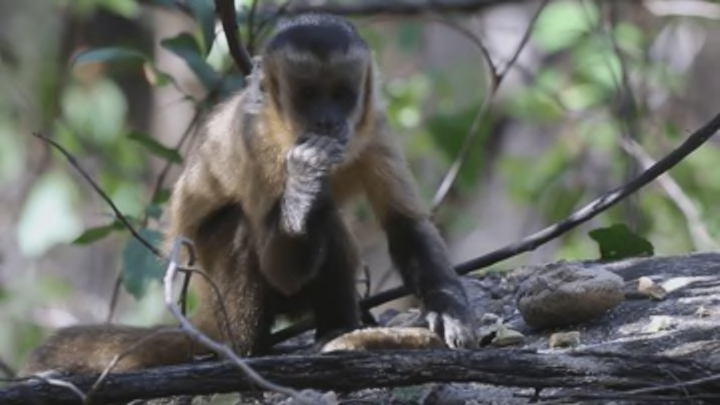Jane Goodall’s discovery of chimpanzee tool use in 1960 came as a shock to her contemporaries, who believed that our ability to make and wield instruments set us above other animals. Since that time, we’ve gradually learned that lots of animals, from birds to insects, make and use tools. Some of them have been at it for a long, long time: Archaeologists have found that Brazilian capuchin monkeys have been using hammers to crack nuts for at least 700 years. That makes their stone hammers and anvils the oldest non-human tools known outside of Africa, the researchers write in a report they published this week in the journal Current Biology.
Image credit: Michael Haslam/Primate Archaeology Project
The bearded capuchin (Sapajus libidinosus) is a nimble little monkey found in the forests of northeast Brazil. S. libidinosus is not a particularly picky eater, and will happily chow down on flowers, fruit, leaves, bugs, frogs, small mammals, and baby birds. But scientists are most interested in the monkey’s taste for cashews. For the love of cashews, the bearded capuchin has learned to wield a small stone like a hammer, smashing the nut’s tough shell open on an anvil-like large stone. The monkey will then leave the tools in a pile by the cashew tree for next time. Hammer, crack, eat, repeat.
Archaeologists suspected that the capuchins had been repeating for a long, long time. To find out just how long, they used hand trowels to excavate the soil under four popular modern-day nut-smashing sites. They didn’t have to look very far to find what they were looking for; digging just 0.7 meters (2.29 feet) down yielded 69 different cashew-smashing implements.
The tools were surprisingly easy to identify. They looked exactly like the same stones preferred by today’s monkeys, and many of the rocks were smudged with cashew resin (a fact confirmed by chemical testing). And just like today’s monkey tools, most of the unearthed hammers were made of hard, smooth quartzite, while the anvils were flat sandstone.
The dig had also unearthed little pieces of charcoal. By carbon dating those pieces, the team could estimate the age of the stones nearby. They found that the stones could be sorted into three time periods. The stones near the top had been used quite recently. Those in the second layer dated from about 1614–1958, and the bottom layer went all the way back to the year 1266.
Project leader Michael Haslam is an archaeologist at the University of Oxford. “This is an exciting, unexplored area of scientific study that may even tell us about the possible influence of monkeys' tool use on human behavior,” he said in a press statement. “It is possible that the first humans to arrive here learned about this unknown food through watching the monkeys and their primate cashew-processing industry.”
Studying monkey behavior has been quite a shift for Haslam, who’s spent most of his career looking at artifacts and remains. The live animals are a lot more unpredictable, he notes in the video above: “They have their own lives going on. Sometimes you’ll see them beginning to do something really interesting with their tools, and then another monkey comes running in and there’s a big fight, or they have to leave for some reason, or they just fall asleep.”
Know of something you think we should cover? Email us at tips@mentalfloss.com.
